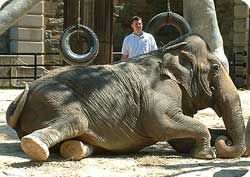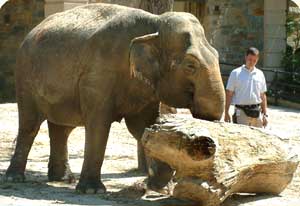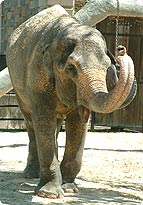
- Related Scientific Publications
- Adopt an Asian Elephant!
- See Asian Art at the Smithsonian's Freer and Sackler Galleries
- AZA Elephant Species Survival Plan
Elephant Training
How do you get a four-ton elephant to say, "Ahhh"? With training and patience, keepers can get one of the world's largest land mammals to cooperate for a medical exam or a demonstration for visitors.
Every day, while a volunteer narrates, the Zoo's Asian elephants respond to commands and show visitors just how cooperative and majestic they are. ![]() Daily Programs
Daily Programs
The basic steps for training an elephant—and any other animal—are: 1) stimulus 2) response, and 3) reinforcement.
For elephants, this means:
- Stimulus: The keeper provides a stimulus in one of three forms: a spoken command, the visual direction of an elephant hook or target, and/or the touch of an elephant hook or target;
- Response: The elephant responds with all or a small portion of the desired behavior;
- Reinforcement: The keeper reinforces the elephant's response in one or more ways, including: food, praise, and the removal of the stimulus.
Say that again?
- A stimulus is simply a method to communicate to the elephant, giving it information about what you want it to do.
- A response is when the elephant responds to the information by performing the behavior or even a small portion of behavior.
- A reinforcement is a reward for the response.
 |
| Keepers have trained the elephants to lie down on command, should an exam of these tall animals be necessary. |
The trainers must be skilled in providing a stimulus, or information, in a way that the elephant understands. If the elephant can't understand, it will become frustrated.
The trainer must also provide reinforcement, or reward, with precise timing. If the reinforcement is poorly timed, the elephant might think it is being rewarded for a different behavior than the one the trainer wanted.
With tens of thousands of muscles and tendons in the trunk, elephants use this elongated nose for a wide range of tasks, including eating, drinking, and breathing. They can suck up to two gallons of water and spray it into the mouth, and push heavy objects (pictured below) out of the way. When wading in deep water, elephants use the trunk as a snorkel.

Elephants also use their trunks for smelling and for cooling off—they suck up and spray water over their bodies, and scoop up and throw dirt on their backs, which acts as a protective layer against the sun's rays.
 Elephants use the tip of the trunk to pick up food and other objects. Asian elephants have a single finger-like projection at the tip of the trunk; African elephants have two projections.
Elephants use the tip of the trunk to pick up food and other objects. Asian elephants have a single finger-like projection at the tip of the trunk; African elephants have two projections.
They eat grasses, leaves, and fruit by grasping them with the tip of the trunk and dropping them in the mouth. They also skillfully pick up objects as small as a key (pictured at left).
 With elephants living into their fifties and beyond, they need plenty of checkups and care over their long lives. Ambika, one of the Zoo's elephants was born around 1948. Our elephants have been trained to present their mouth, the bottoms of their feet, and other parts for examination and cleaning.
With elephants living into their fifties and beyond, they need plenty of checkups and care over their long lives. Ambika, one of the Zoo's elephants was born around 1948. Our elephants have been trained to present their mouth, the bottoms of their feet, and other parts for examination and cleaning.


